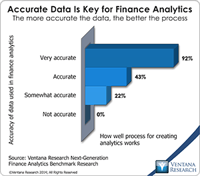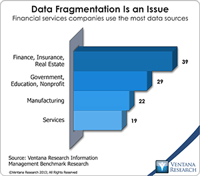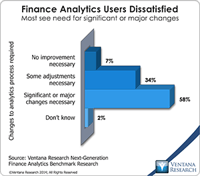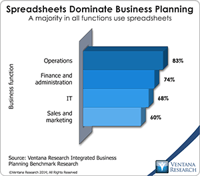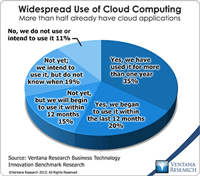Our research consistently finds that data issues are a root cause of many problems encountered by modern corporations. One of the main causes of bad data is a lack of data stewardship – too often, nobody is responsible for taking care of data. Fixing inaccurate data is tedious, but creating IT environments that build quality into data is far from glamorous, so these sorts of projects are rarely demanded and funded. The magnitude of the problem grows with the company: Big companies have more...
Read More
Topics:
Big Data,
Planning,
Predictive Analytics,
Governance,
Office of Finance,
Operational Performance Management (OPM),
Budgeting,
close,
Finance Analytics,
Tax,
Analytics,
Business Analytics,
Business Intelligence,
CIO,
Governance, Risk & Compliance (GRC),
In-memory,
Business Performance Management (BPM),
CFO,
Financial Performance Management (FPM),
Information Applications (IA),
Risk,
Workforce Performance Management (WPM),
CEO,
Financial Performance Management,
FPM
The proliferation of chief “something” officer (CxO) titles over the past decades recognizes that there’s value in having a single individual focused on a specific critical problem. A CxO position can be strategic or it can be the ultimate middle management role, with far more responsibilities than authority. Many of those handed such a title find that it’s the latter. This may be because the organization that created the title is unwilling to invest the necessary powers and portfolio of...
Read More
Topics:
GRC,
Office of Finance,
Operational Performance Management (OPM),
Chief Risk Officer,
CRO,
ERM,
OpenPages,
Business Analytics,
Business Collaboration,
Cloud Computing,
Data Governance,
IBM,
Business Performance Management (BPM),
compliance,
Data,
Financial Performance Management (FPM),
Risk,
Financial Services,
FPM
Business computing has undergone a quiet revolution over the past two decades. As a result of having added, one-by-one, applications that automate all sorts of business processes, organizations now collect data from a wider and deeper array of sources than ever before. Advances in the tools for analyzing and reporting the data from such systems have made it possible to assess financial performance, process quality, operational status, risk and even governance and compliance in every aspect of a...
Read More
Topics:
Big Data,
Planning,
Predictive Analytics,
Governance,
Office of Finance,
Budgeting,
close,
Finance Analytics,
Tax,
Analytics,
Business Analytics,
Business Intelligence,
CIO,
Governance, Risk & Compliance (GRC),
In-memory,
Business Performance Management (BPM),
CFO,
Financial Performance Management (FPM),
Information Management (IM),
Risk,
CEO,
Financial Performance Management,
FPM
Anaplan, a provider of cloud-based business planning software for sales, operations, and finance and administration departments, recently implemented its new Winter ’14 Release for customers. This release builds on my colleagues analysis on their innovation in business modeling and planning in 2013. Anaplan’s primary objective is to give companies a workable alternative to spreadsheets for business planning. It is a field in which opportunity exists. Our benchmark research on this topic finds...
Read More
Topics:
Big Data,
Performance Management,
Planning,
Predictive Analytics,
Marketing,
Office of Finance,
Operational Performance Management (OPM),
Operations,
Reporting,
Budgeting,
Controller,
Business Analytics,
Cloud Computing,
In-memory,
Business Performance Management (BPM),
CFO,
Financial Performance Management (FPM),
Sales Performance Management (SPM),
Sales Planning,
Supply Chain Performance Management (SCPM),
Workforce Performance Management (WPM),
Financial Performance Management,
financial reporting,
FPM,
Integrated Business Planning
There’s a growing realization that the multitenant approach to the cloud isn’t the only option that companies should weigh in deciding between deploying software on-premises and in the cloud. That some people describe the multitenancy approach as “the real cloud” reflects the contentious nature of some technical debates, especially those that occur early in the evolution of a new technology. Multitenancy does have advantages that confer cost savings, and these have been important in the first...
Read More
Topics:
Microsoft,
Mobile,
SaaS,
Sales,
Salesforce.com,
ERP,
HCM,
Human Capital,
Office of Finance,
Planview,
Concur,
Dynamics AX,
Dynamics GP,
Dynamics NAV Dynamics SL,
PSA,
Sage Software,
Unit4,
Analytics,
Cloud Computing,
Business Performance Management (BPM),
CFO,
Financial Performance Management (FPM),
FinancialForce,
HR,
Infor,
Tagetik,
Workday,
Workforce Performance Management (WPM),
Plex
